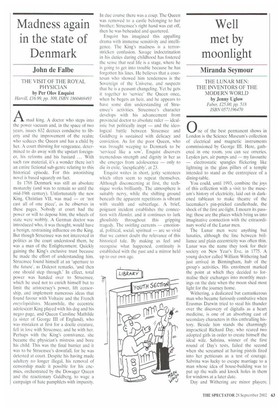Well met by moonlight
Miranda Seymour
THE LUNAR MEN: THE INVENTORS OF THE MODERN WORLD by Jenny Uglow Faber, i25.00, pp. 518 ISBN 0571196470 0 ne of the best permanent shows in London is the Science Museum's collection of electrical and magnetic instruments commissioned by George III. Here, gathered in one room, you can see orreries, Leyden jars, air pumps and — my favourite — electrostatic spangles flickering like lightning in the glass pillars of a temple intended to stand as the centrepiece of a dining-table.
You could, until 1993, combine the joys of this collection with a visit to the museum's history of electricity, laid out in darkened tableaux to make theatre of the lacemaker's pin-pricked candleshade, the shock of the first arc-light. I mourn its passing; these are the places which bring us into imaginative connection with the extraordinary world of the Lunar men.
The Lunar men were anything but lunatics, although the line between brilliance and plain eccentricity was often thin. Lunar was the name they took for their society on New Year's Eve, in 1775. A young doctor called William Withering had just arrived in Birmingham, hub of the group's activities. His enrolment marked the point at which they decided to formalise their exchanges into monthly meetings on the date when the moon shed most light for the journey home.
Withering, a dedicated but cantankerous man who became furiously combative when Erasmus Darwin tried to steal his thunder over the discovery of digitalis as a heart medicine, is one of an absorbing cast of secondary characters in this enthralling history. Beside him stands the charmingly impractical Richard Day, who reared two adopted girls in order to create himself the ideal wife. Sabrina, winner of the first round of Day's tests, failed the second when she screamed at having pistols fired into her petticoats as a test of courage. Sabrina was lucky to escape marriage to a man whose idea of house-building was to put up the walls and knock holes in them for windows at a later date.
Day and Withering are minor players; above them stand Joseph Priestley, whose invention of soda water helped lay the foundation of the Schweppes empire, and Joseph Wright, whose paintings capture the intense excitement of the world Jenny Uglow has magnificently portrayed. Climb higher, past Humphry Davy, James Watt and Benjamin Franklin, and you're rubbing shoulders with the men without whom the Lunar Society would never have come about.
And what men they are — Dr Erasmus Darwin, the intellectually voracious grandfather of Charles, Josiah Wedgwood, founder of the pottery which helped to form the artistic taste of Britain's new middle classes, and the dynamic, genially unscrupulous Matthew Boulton, a merchant prince who began his career by inlaying steel buckles with enamel at the tender age of 17 and ended by creating a mint which produced for the Empire. James Watt, Boulton's partner, was among their colleagues; they were as eagerly committed to the development of the steam engine as to the reshaping of the transport system by the creation of a vast network of canals. (All the lunar men had shares in the canal system.)
Curiosity, the desire for intellectual exchange and faith in progress kept the three men together through difficult times. All were united by the thrill of 'fossilising' at the time when the Trent-Mersey canal was being dug. Wedgwood, assisted by his friends, hunted for a new type of stone which would enable him to produce earthenware white as the finest porcelain; Darwin became ecstatic after a journey deep into the mineral-rich caves of Derbyshire to see the Goddess of Minerals naked, as she lay in her inmost bowers'. Returning home with his pockets full of stones, he plotted Innumerable experiments ... Food for fire engines!' Fossilised shells led him to question creationism; boldly, he added three scallop shells to his crest, incurring the wrath of the local community for such sacrilege. The scallop shells were, reluctantly, removed.
Wedgwood, meanwhile, used the Derbyshire fluorspar, Blue John, to create some of his most elaborate pieces, glorious vases which reflected the age's new taste for classical objects. Boulton, a salesman to his fingertips, encouraged his agents to present themselves each as the one and only' outlet of these fabulous wares, until Wedgwood gently reminded him that this was not quite the case. Their friendship was tested more severely when Boulton, with an eye on his Tory patrons, decided to support British interests in America's war for independence. The Lunar men were dismayed; one former colleague, Benjamin Franklin, briskly cut his links to the Birmingham set.
All heroes have their faults. Wedgwood's sudden enthusiasm for basalt tableware was fuelled by commerce, not aesthetics (black plates would sell especially well, he calculated, to the elegant hostesses who bleached their fingers with arsenic). Darwin, while generous and enthusiastic, was a ruthless appropriator of his colleagues' discoveries and work. Anna Seward was not pleased to have her poem snatched and anonymously displayed in his bestselling work, The Botanic Garden: Withering was apoplectic when Darwin pre-published his discovery of the medicinal value of foxgloves.
This is an irresistible book, rich as a Christmas pudding in its detail. Uglow is the perfect guide, lucid, intelligent, sympathetic and wise. A wonderful subject has found its perfect historian.



































































































 Previous page
Previous page